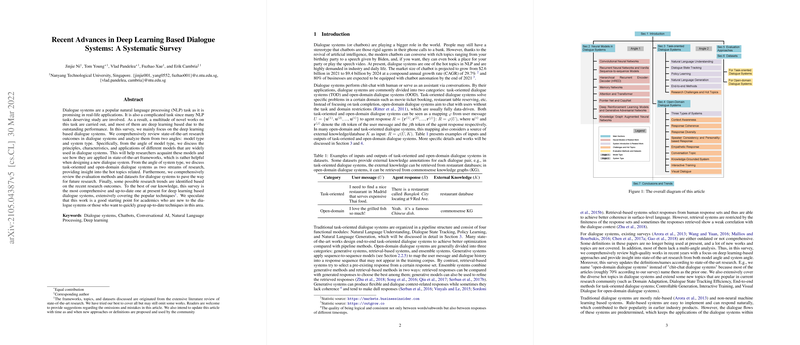Advances in Deep Learning-Based Dialogue Systems: A Comprehensive Survey
The paper "Recent Advances in Deep Learning Based Dialogue Systems: A Systematic Survey" offers an extensive overview of the state-of-the-art developments in dialogue systems focused on deep learning models. It addresses a crucial area of NLP by chronicling both model types and system types that underline modern dialogue frameworks, particularly those driven by deep learning, which have demonstrated notable performance gains.
Overview and Classification
The survey categorically splits dialogue systems into two major types based on application: task-oriented dialogue systems (TOD) and open-domain dialogue systems (OOD). The paper provides a detailed review from both the model perspective and the system perspective, showcasing the principles, characteristics, and applications of different architectures employed within these classifications. From task completion to open-ended conversational tasks, the survey explores how each system type interacts with and benefits from deep learning advancements.
Model Types and Architectures
Significant attention is paid to the architectures invigorating current dialogue systems. The paper discusses:
- Convolutional Neural Networks (CNNs): Leveraged for text feature extraction but rarely as the primary encoders due to their limitations in sequence point processing.
- Recurrent Neural Networks (RNNs) and Variants: Including LSTMs, GRUs, and bidirectional RNNs, utilized for their proficiency in handling sequential data, a staple in dialogue systems.
- Sequence-to-Sequence Models: A crucial architecture for generative tasks with discussions on attention mechanisms and Transformer models, which have reshaped the landscape of sequential modeling.
- Memory Networks and Copy Mechanisms: Addressing the need for systems to access and utilize external knowledge bases or past interactions.
- Advanced Techniques: Such as Deep Reinforcement Learning and Generative Adversarial Networks (GANs) that bring dynamism and adaptability to system responses.
System Types and Evaluation
The survey articulates the nuance between modular approaches and holistic end-to-end training in task-oriented systems, highlighting the former's methodological clarity and fine-tuned control versus the latter’s inherent flexibility and scalable adaptability. It also addresses the challenge of evaluating dialogue systems, noting the divergence between task-oriented system metrics and those suitable for open-domain systems.
Research Challenges and Future Directions
A key component of the paper lies in identifying persistent challenges and open questions in dialogue system development. For task-oriented systems, issues like dialogue state tracking efficiency, policy learning robustness, and cross-domain adaptability are underscored. In open-domain dialogue systems, challenges revolve around maintaining contextual relevance and producing responses that are both diverse and coherent.
The paper speculates on future paths this field may take, suggesting that multimodal dialogue systems, enhanced by integrative learning across modalities, and evolving user modeling techniques could drive new advancements. Additionally, adapting systems through few-shot learning and leveraging vast unstructured data from the internet represent foundational elements for next-generation conversational AI.
Conclusion
This survey stands as a valuable resource for researchers, mapping the landscape of current methodologies and technologies underpinning dialogue systems. By synthesizing a wealth of research, it not only provides a benchmark of existing capabilities but also serves as a springboard for future exploration and innovation in dialogue system technology. This comprehensive coverage is indispensable for those looking to understand the intricacies of dialogue systems or seeking to contribute to this rapidly advancing field.
